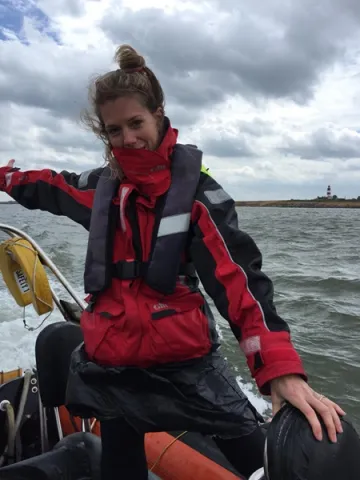Project overview
The beach replenishment programme from Clacton to Holland-on-Sea, Essex, carried out between 2014 and 2015, resulted in the appearance and collection of both Pleistocene mammalian remains and stone tools, including Early Middle Palaeolithic Levallois; one of the largest in the country.
The sands used in this coastal protection scheme derived from offshore licence Area 447. As such, this raised questions surrounding the measures of mitigation that had been in place for Area 447, the subsequent beach replenishment programme during the EIA stage, and the potential to recover information from pre-existing, split-open vibrocores.
Due to these concerns, Historic England commissioned the University of Southampton (Project 7738, led by Dr Rachel Bynoe) to assess the existent datasets available for Area 447 to permit the reconstruction of a narrative around the formation of the archaeological deposits extracted from Area 447 and their subsequent use, which will in turn develop advice available for regulatory bodies for the production of EIAs and coastal and offshore mitigation.
This project also aims to identify the reasons why current industry standard methodologies failed to identify this archaeological resource. It addresses current methodological issues surrounding the collection, interpretation and analysis of geophysical and geotechnical data offshore, as well as the use of watching briefs, and how this might be adapted to better identify this type of archaeology in future.
Several geophysical, geotechnical and dredging-related datasets, collected between 1990 and 2015, were made available for this project, analyses of which indicate that the sequence can be dated to Marine Isotope Stage (MIS) 7 / 6.
Clast analysis identified four flint clast types, with three showing limited abrasion and attrition, while the fourth could be associated with a beach environment.
Molluscs present throughout the sequence were associated with a shallow intertidal / sublittoral coastal environment. Pollen indicated a late temperate stage assemblage comparable to dated British terrestrial sequences from late MIS 7, and paired mineral luminescence dating has provided statistically consistent dates confirming that these deposits are of late MIS 7 / early MIS 6 age.
The results from VC23 in Area 447 firmly place the site within late MIS 7 / early MIS 6, probably correlated with the MIS 7a-6e interglacial to glacial transition, fitting in with the dominant archaeological signature from the site.
Through the reconstruction of a narrative around the formation and hominin use of these landscapes, at a point immediately prior to their abandonment of Britain from MIS 6 - 3, this project raises important questions about how we interpret their occupation. Are we starting to see the evidence for relatively increased exploitation of these lower-lying areas, either because of resource availability, dispersal routes, or both, or is this simply a result of visibility provided by these beach replenishments schemes – large areas of dredged material being laid out in a publicly accessible area.
While impossible to say at this stage, the results of this project combined with those from Area 240 (e.g. Tizzard et al. 2014) and the current work at Walcott (Davis et al. 2023) are starting to provide more and more evidence with which to inform and support interpretations of these obscured landscapes.
Furthermore, this study demonstrates that luminescence dating can be successful on vibrocores which have not been sampled under optimal conditions. It demonstrates that archived vibrocores can be successfully used to reassess a site where the archaeological deposits have already been removed and primary context lost. Recommendations for future mitigation against the loss of information provided by such deposits have been provided as a result of these analyses.
The sands used in this coastal protection scheme derived from offshore licence Area 447. As such, this raised questions surrounding the measures of mitigation that had been in place for Area 447, the subsequent beach replenishment programme during the EIA stage, and the potential to recover information from pre-existing, split-open vibrocores.
Due to these concerns, Historic England commissioned the University of Southampton (Project 7738, led by Dr Rachel Bynoe) to assess the existent datasets available for Area 447 to permit the reconstruction of a narrative around the formation of the archaeological deposits extracted from Area 447 and their subsequent use, which will in turn develop advice available for regulatory bodies for the production of EIAs and coastal and offshore mitigation.
This project also aims to identify the reasons why current industry standard methodologies failed to identify this archaeological resource. It addresses current methodological issues surrounding the collection, interpretation and analysis of geophysical and geotechnical data offshore, as well as the use of watching briefs, and how this might be adapted to better identify this type of archaeology in future.
Several geophysical, geotechnical and dredging-related datasets, collected between 1990 and 2015, were made available for this project, analyses of which indicate that the sequence can be dated to Marine Isotope Stage (MIS) 7 / 6.
Clast analysis identified four flint clast types, with three showing limited abrasion and attrition, while the fourth could be associated with a beach environment.
Molluscs present throughout the sequence were associated with a shallow intertidal / sublittoral coastal environment. Pollen indicated a late temperate stage assemblage comparable to dated British terrestrial sequences from late MIS 7, and paired mineral luminescence dating has provided statistically consistent dates confirming that these deposits are of late MIS 7 / early MIS 6 age.
The results from VC23 in Area 447 firmly place the site within late MIS 7 / early MIS 6, probably correlated with the MIS 7a-6e interglacial to glacial transition, fitting in with the dominant archaeological signature from the site.
Through the reconstruction of a narrative around the formation and hominin use of these landscapes, at a point immediately prior to their abandonment of Britain from MIS 6 - 3, this project raises important questions about how we interpret their occupation. Are we starting to see the evidence for relatively increased exploitation of these lower-lying areas, either because of resource availability, dispersal routes, or both, or is this simply a result of visibility provided by these beach replenishments schemes – large areas of dredged material being laid out in a publicly accessible area.
While impossible to say at this stage, the results of this project combined with those from Area 240 (e.g. Tizzard et al. 2014) and the current work at Walcott (Davis et al. 2023) are starting to provide more and more evidence with which to inform and support interpretations of these obscured landscapes.
Furthermore, this study demonstrates that luminescence dating can be successful on vibrocores which have not been sampled under optimal conditions. It demonstrates that archived vibrocores can be successfully used to reassess a site where the archaeological deposits have already been removed and primary context lost. Recommendations for future mitigation against the loss of information provided by such deposits have been provided as a result of these analyses.

